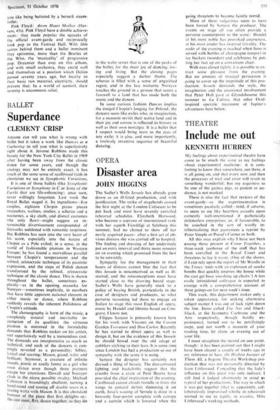BALLET
Superdance
CLEMENT CRISP
Anyone can tell you what is wrong with ballet but it takes a work like Dances at a Gathering to tell you what is superlatively right about it. Jerome Robbins made this beauty for the New York City Ballet in 1969 after having been away from the classic dance for some years, and though the analogy may not be entirely exact, it has much of the same sense of reaffirmed faith in classicism we see in Symphonic Variations.
It is one of those ballets (like Symphonic Variations or Symphony in C or Song of the Earth) that are life-enhancing: once seen, never willingly forgotten. Last week the Royal Ballet staged it. Its ingredients—five couples, eighteen Chopin piano pieces (mazurkas, waltzes, studies, a scherzo and a nocturne), a sky cloth, and dismal costumes (the only flaw)—might suggest an in- terminable divertissement compounded of fireworks soddened with romantic mopiness. But Robbins has seen into the very heart of his score, especially into the nature of Chopin as a Pole exiled; in a sense, in the world of fashionable pianism in Western Europe; he has found a marvellous parallel between Chopin's temperament and the refined, aristocratic technique of its pianistic expression, and the steps of Polish dances transformed by the refined, aristocratic technique of the classic dance. This is shown throughout the ballet, sometimes ex- plicitly—as in the opening mazurka for Nureyev--sometimes implicitly, in numbers that have little apparent national element in either music or dance, where Robbins suddenly reveals the inherent Polishness of Chopin's attitude.
The choreography is born of the music, a completely natural and inevitable in- carnation of its qualities; the virtuoso pianism is mirrored in the formidable demands that Robbins makes on his artists, met superlatively well by a tremendous cast. The demands are interpretative as much as technical, and each of the dancers is cun- ningly revealed as a personality; Sibley, lyrical and soaring; Mason, grand, witty and brilliant; Seymour, a creature of infinite moods, poetic or zanily funny as a girl who must dance even though three partners escape her attentions. Dowell and Nureyev clash in the nicest possible rivalry; Michael Coleman is boundingly ebullient, turning a hand-stand and tossing off double tours in a teasing waltz with Mason. It is this abundant humour of the piece that first delights us: the cast meet, flirt, dance together, as they do
in the waltz sextet that is one of the peaks of the ballet, for the sheer joy of dancing, lov- ing and lix ing. But the closing pages especially suggest a darker theme. The scherzo is filled with a sense of anguished regret, and in the last nocturne Nureyev touches the ground in a gesture that seems a farewell to a land that has made both the music and the dances.
In some curious fashion Dances implies the emigre Chopin's longing for Poland; the dancers seem like exiles who, in imagination, for a moment revisit their native land and in their joy and sorrow is reflected its history as well as their own nostalgia. It is a ballet that I suspect would bring tears to the eyes of any exile; it is also, and more importantly, a tirelessly inventive sequence of beautiful dancing.










































 Previous page
Previous page